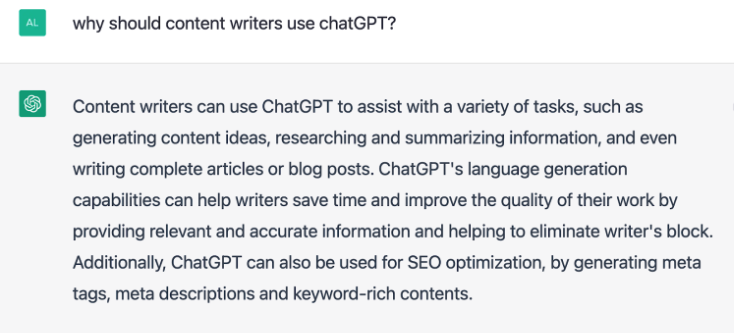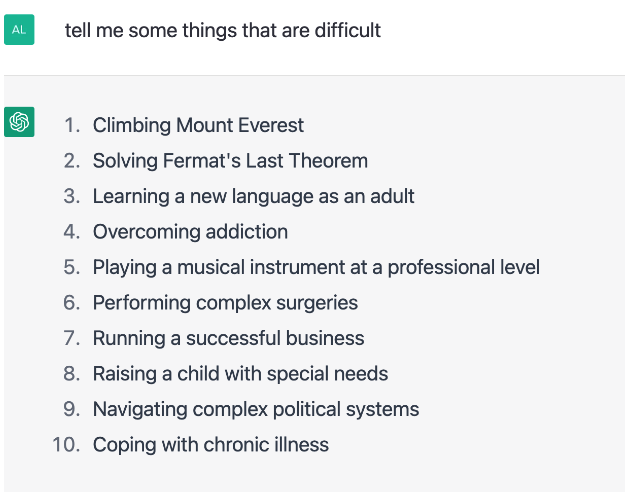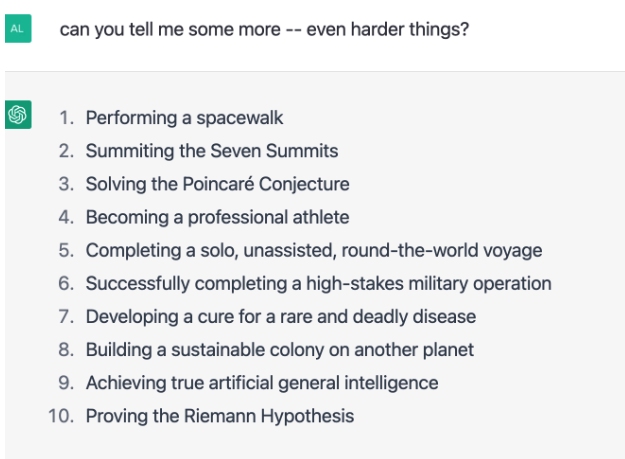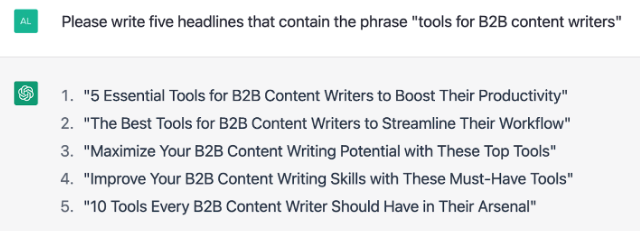More and more B2B companies are expanding their content marketing efforts, which means the demand for content writers is greater than ever. Today we look at 6 of the most common B2B content writing tools seasoned writers (including our own) use to stay ahead.
Lately, there’s been a lot of fretting about whether artificial intelligence will replace content writers. It would be a boon for B2B companies as robot-written content is cheaper than content written by humans. Though some B2B companies are already exploring Jasper and other AI-powered blog writing services, we think that’s premature.
Even ChatGPT – the latest and greatest AI-powered tool – is a poor replacement for a human. We’ll explain more below. For now, just know that using AI to craft your blog content would be like replacing a senior writer with a high school student. Sure, you could do that – but do you really want to?
Until artificial intelligence improves (and even when it does), human content writers are here to stay. To stay ahead of the competition, however, content writers can use artificial intelligence (among other B2B content writing tools) to work faster and smarter. Below we’ll show you how.

6 Powerful B2B Content Writing Tools for 2023
- Brainstorm with the Help of ChatGPT
- Use Artificial Intelligence to Check Grammar, Spelling, and Style
- Power Up Copy with SEO Tools
- Stay on Top of Blog Trends and Topics
- Use Online Tools to Create Visual Content
- Quickly Generate Study Citations
1. Brainstorm with the Help of ChatGPT
By now, you’ve likely heard something about ChatGPT.
Released in November and available for free from the open AI research lab, the artificial-intelligence chatbot interacts with users in a super conversational way.
Many people have written about its amazing powers, especially how the chatbot can bang out convincing blog posts that almost sound as if a human wrote them.
We’ll tell you right now…
We’re not impressed with ChatGPT’s blog writing abilities.
Here’s why. It uses the entire Internet as a content source. That means that a lot of the content chatGPT (and other AI chatbots) produces is… questionable. There’s a very high risk that the content it spits out could land you in hot water when it comes to accuracy (this happened to CNET most recently). Most concerning, however, is that it produces generic copy that lacks personality.
Take the below. It’s okay – but only okay.

ChatGPT isn’t the right tool for writing entire blog posts for all of the above reasons and more. You’ll want a human being for that task, especially if you’re looking for blog content that’s alive with voice and personality.
ChatGPT does, however, excel at brainstorming – both for content ideas in general and for specific points to include in your content. Below we list a few ways content writers might use it.
✅Get Help with Analogies.
Remember: ChatGPT is not a human coworker.
So, don’t bother asking it to come up with the whole analogy. Otherwise it will spit out unhelpful suggestions like, “Climbing Mount Everest is like trying to move a mountain.” Gee, thanks, chatbot.
It can, however, help you brainstorm parts of your analogy.
Let’s say you already know the beginning of your sentence: “Coming up with a brilliant analogy when you’re sleep deprived is like…” Now you need to come up with some things that are difficult. This is where ChatGPT shines.

If you’re not happy with the first suggestions, you can ask it to keep going until you get an answer that suits you.

✅Find Ideas for What to Include in Your Post.
As we put together this article, we asked ChatGPT what writing tools we should make sure to mention. This is what it told us.

✅Generate Headline Suggestions.
Maybe you’ve got a keyword, but you’re stuck on how to use that keyword in a headline. Ask ChatGPT for a few ideas to get you started.

(Read more: Can AI Write Marketing Content?)
2. Use Artificial Intelligence to Check Grammar, Spelling, and Style.
Several SaaS brands have created digital products that use artificial intelligence as a digital writing assistant that points out incorrect grammar and other writing mistakes. Below you’ll find four of the best B2B content writing tools for checking the basics.
The free version checks grammar, spelling, and punctuation in documents that are 500 words or fewer. It also contains a thesaurus.
For $10 a month, the paid version comes with an unlimited word count, style guide, citation tool, writing suggestions, and collaboration abilities. Detailed writing reports help you check for cliches, plagiarism, and overused words.
This robust desktop app (and favorite of our own writers) will look for writing mistakes everywhere you write, including WordPress, social media, and more.
The free version helps you with grammar, spelling, punctuation, conciseness, and tone. Premium ($12 a month) and Business ($15 a month) do much more. You can ask it to help make your writing sound more “friendly” or “formal,” to ensure your language is inclusive, format citations, and check for plagiarism. The business version allows you to input your company’s style guide.
If your company already uses Microsoft 365, its EditorApp will automatically do many of the tasks as the tools mentioned above, including checking for spelling, grammar, punctuation, and tone. The “check accessibility” feature ensures your pictures include alt text and that your document breaks up the text with headings. An editor score helps you improve conciseness, inclusiveness, and clarity in real time.
You can cut and paste the text into Heminway’s free web-based tool to see if you’ve used unnecessary adverbs, passive voice, overly complicated phrasing, or difficult-to-read sentences. It will also score your writing based on readability.
If cutting and pasting sounds like too much work, a one-time $19.99 payment buys you the paid desktop version, which integrates with WordPress, allowing you to publish directly from the app.
(Read more: Three AI Tools for Business Marketers.)
3. Power Up Copy with SEO Tools
If you’ve been writing web content for longer than a month, then you likely already use an SEO tool like SemRush to help you generate and use keywords in your headlines and copy.
(And it may go without saying: If you’re not using an SEO tool for keyword analysis, you’re likely missing out on web traffic.)
For slightly more money, however, you can get even more functionality from some SEO apps. Clearscope, Hubspot, and Semrush all offer desktop apps that fully integrate with Google docs and WordPress. Once they’re up and running, these tools offer AI-powered SEO suggestions in real time, as you write.
Not only will they suggest ways to work keywords into copy, but they also recommend related phrases so you can beat out the competition in your Google game. An added bonus: They’ll help ensure you don’t overuse your keywords, so you won’t get penalized for keyword stuffing. These tools can also remind you to use alt text, check for broken links, and perform many other tasks that help you improve your search rankings.
(Related: 5 Things Beginners Need to Know About SEO).
4. Stay on Top of Blog Trends and Topics
If you’re running out of blog ideas, the following FREE tools are here to offer some inspiration.
Answer the Public generates hundreds of questions people ask search engines. For example, if you typed “B2B marketing” into the search box, Answer the Public would spit out 349 questions, comparisons, and phrases that people wonder about, such as “business to business marketing on TikTok” and “business to business marketing template.”
Google search console tells you what people are searching for to land on your site. The goal is to help you monitor, maintain, and troubleshoot your site’s presence in Google Search results.
(Read more: How to Develop Endless B2B Blog Post Ideas.)
5. Use Online Tools to Create Visual Content
Stock art sites like iStockPhoto and Shutterstock offer photos and graphics for a fee.
Canva, Biteable, and PicMonkey are design tools that allow you to quickly and easily make graphics and videos for social and blog content. Both come with free versions or a free trial, along with more features if you opt for a paid account.
(Related: Is My B2B Content Effective?)
6. Quickly Generate Study Citations.
If your B2B writing includes highly sourced medical content, Paperpile can speed up your process. The business version costs $9.99 a month and integrates with Chrome and Google, allowing you to add studies to your research library at the click of a button. Once you set your citation style (AMA, APA, Vancouver, Chicago, MLA) it will generate the citation for you in the correct format that you can easily add to your document.
Conclusion: B2B Content Writing Tools Turn Good (Human) Writers into Great Ones.
Successful content writers don’t see artificial intelligence as an existential threat. Instead, they harness it and other B2B content writing tools to help them outperform their competition. When used effectively, these tools can improve your copy as well as help you write a lot more of it. End result, you get more done.



